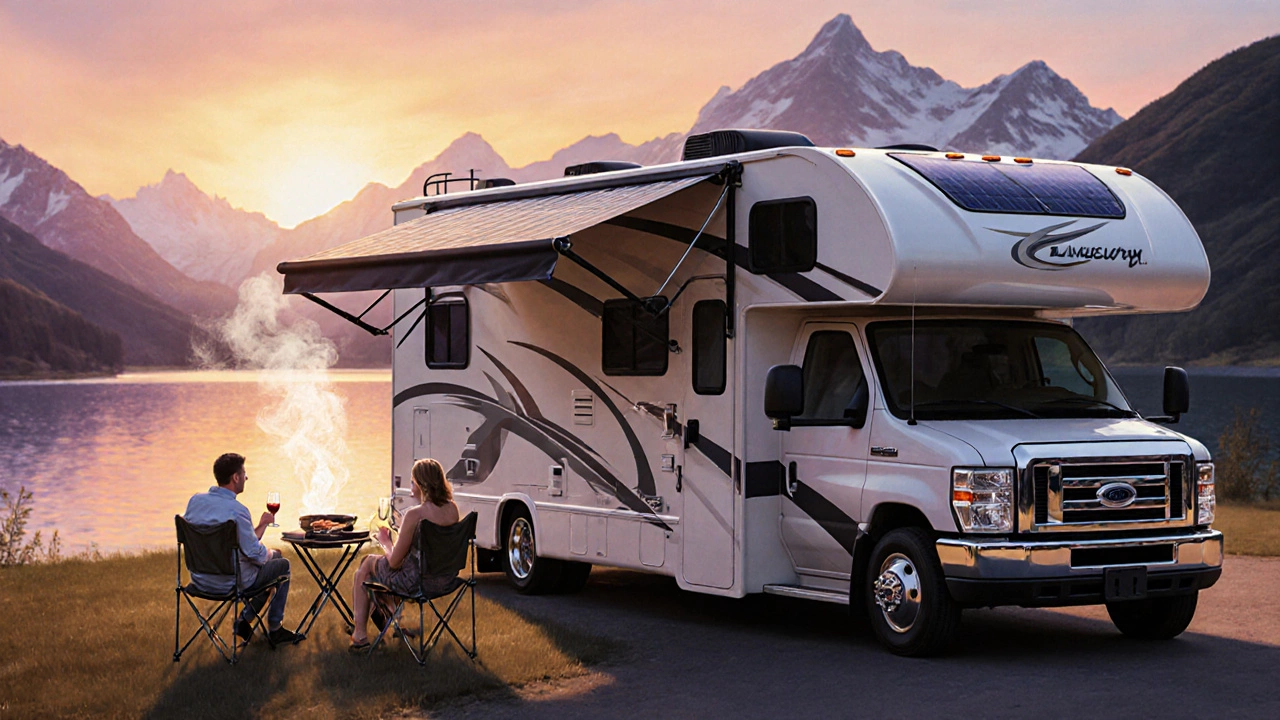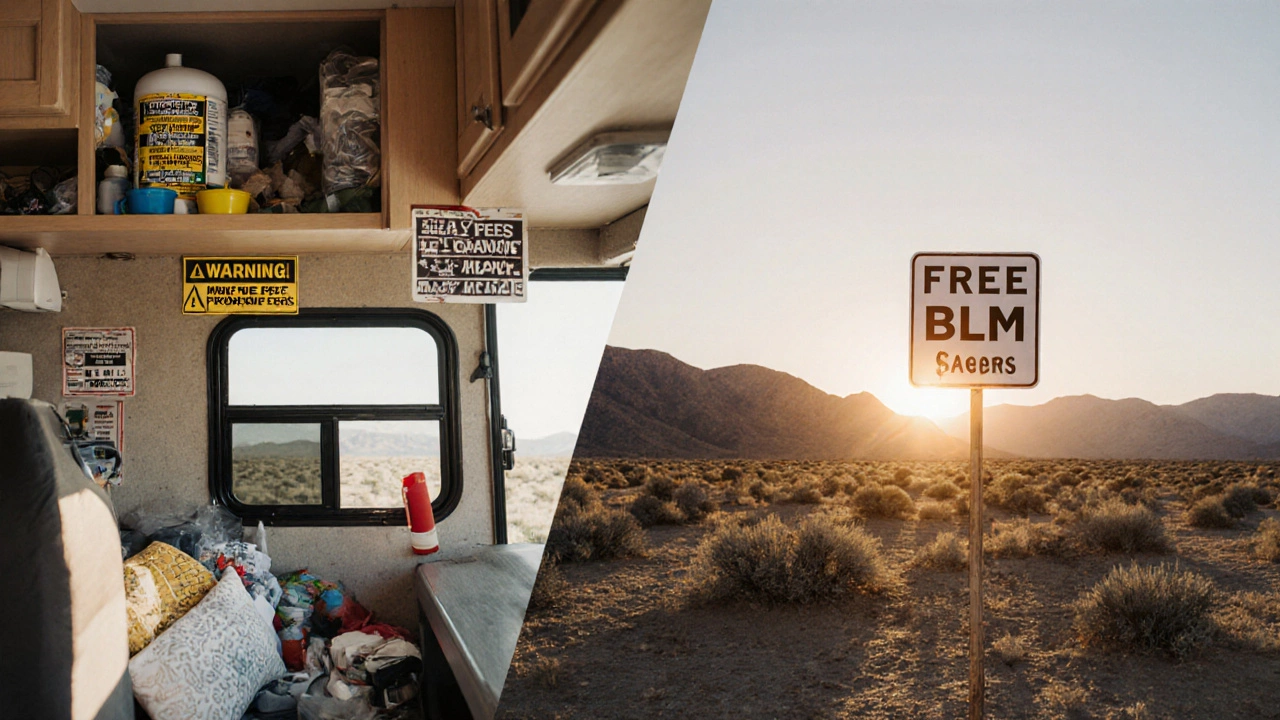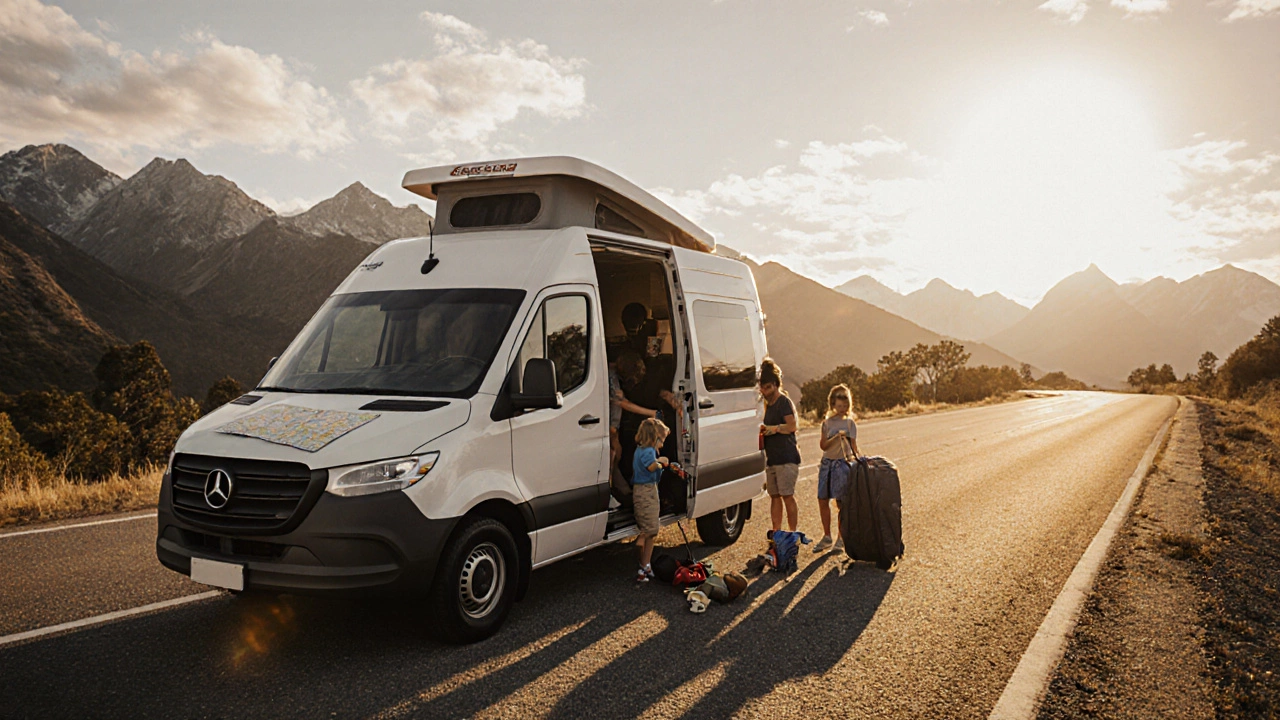RV Rental Cost Calculator
Calculate Your 2-Week RV Rental Cost
Estimate costs based on your preferred RV type, season, and additional options
Estimated Total Cost
$0
- Base Rental: $0
- Insurance: $0
- Delivery: $0
- Propane: $0
- Cleaning Fee: $0
Planning a two-week RV road trip across America? You’re not alone. Thousands of travelers rent RVs every year to explore national parks, coastal highways, and desert towns without booking hotels. But the big question isn’t just how much is it to rent an RV in America for 2 weeks? It’s: What are you actually paying for?
RV Rental Prices Vary Wildly - Here’s Why
Don’t expect one flat rate. An RV rental in the U.S. can cost anywhere from $1,200 to $8,000 for two weeks. That’s a huge gap. Why? Because RVs aren’t cars. They come in different sizes, ages, features, and demand levels.
A small Class B camper van - think Volkswagen Westfalia style - might run you $80-$120 per night in low season. That’s around $1,120-$1,680 for two weeks. But if you want a luxury Class A motorhome with a full kitchen, washer/dryer, and slide-outs? You’re looking at $300-$600 per night. Multiply that by 14 days, and you’re at $4,200-$8,400.
Season matters a lot. Renting in May or September? Prices drop 20-30% compared to summer. July and August? You’ll pay peak rates - and some companies won’t even rent for less than 14 days. Winter? You might find discounts, but you’ll be stuck with a heater that’s barely keeping up.
What’s Included - And What’s Not
Most rental companies list a base price, but that’s not the full story. Here’s what you’re likely paying extra for:
- Insurance: Basic liability coverage is often included, but collision damage waiver (CDW) is extra - usually $15-$30 per day. That’s another $210-$420 over two weeks.
- Delivery and pickup: If you don’t want to pick up the RV at a depot, some companies will deliver it to your airport or home for $100-$300.
- Generator use: Many RVs have onboard generators for power when off-grid. Some rentals charge $5-$10 per day to use it - $70-$140 extra.
- Propane: Tanks are usually full when you pick up, but you pay for what you use. Most companies charge $5-$8 per gallon. A full tank runs $50-$80.
- Cleaning fee: Even if you clean it yourself, expect a mandatory $100-$200 fee for deep cleaning and waste tank disposal.
Some companies bundle insurance and cleaning. Others charge you for every little thing. Always ask for a line-by-line breakdown before you sign.
Where to Rent - Big Brands vs. Peer-to-Peer
You’ve got two main options: big rental chains or peer-to-peer platforms.
Big brands like Cruise America, El Monte, and RVshare (their corporate side) offer standardized vehicles, 24/7 roadside assistance, and clear return policies. But they’re pricier. You’re paying for reliability - and sometimes, outdated models.
Peer-to-peer platforms like Outdoorsy and RVshare (individual owners) let you rent directly from private owners. Prices are often 20-40% lower. You might get a newer RV with custom upgrades - like solar panels or a rooftop AC. But you’re on your own for roadside help unless the owner offers it. Some owners won’t let you take the RV out of state. Others require you to pay for mileage over 100 miles per day.
One traveler rented a 2023 Forest River RV from a private owner in Arizona for $220/night. The rental included unlimited miles, free propane, and a $50 credit for campsite fees. Total for two weeks: $3,080. Same model from a corporate rental? $4,800.

Hidden Costs That Surprise People
Here’s what most first-timers don’t think about:
- Deposits: Most companies hold $1,000-$2,500 on your credit card. That’s not a charge - it’s a hold. But it can block your available credit, which matters if you’re traveling with a low limit.
- Damage fees: A scratch on the bumper? $300. A dent in the side? $800. Even a dirty toilet tank can trigger a $150 cleaning fee. Take photos before you leave and after you return.
- Mileage limits: Many rentals cap you at 100-150 miles per day. Go over? You pay $0.35-$0.75 per extra mile. Drive 200 miles one day? That’s $35-$75 right there.
- One-way fees: If you pick up in Orlando and drop off in San Francisco? Expect a $1,000-$2,000 drop-off fee. Some companies won’t even allow it.
One couple rented a Class C RV in Seattle and drove to Yellowstone. They didn’t realize the daily mileage limit was 120 miles. They drove 180 miles on day three. The company charged them $45 per extra mile. Total: $270. They didn’t see it until their credit card statement two weeks later.
How to Save Money on a 2-Week RV Rental
You don’t have to break the bank. Here’s how real travelers cut costs:
- Book early: Rentals are cheapest 3-6 months out. Last-minute deals are rare - unless someone cancels.
- Travel shoulder season: April-May and September-October are ideal. Weather’s still good. Prices are half of summer.
- Choose a smaller RV: A Class B or small Class C saves you $100-$200 per night compared to a giant Class A.
- Use free campsites: BLM land, national forests, and Walmart parking lots often let you stay overnight for free. Avoid paying $50-$80 per night for RV parks unless you need hookups.
- Bring your own gear: Don’t rent linens, cookware, or towels. Most rentals charge $10-$25 per item.
- Check for discounts: AAA, AARP, and military members often get 5-15% off. Some companies offer weekly discounts.
One family rented a 2022 Winnebago for $150/night in October. They drove 1,800 miles over 14 days. They used free BLM sites, packed their own food, and skipped insurance because they had good auto coverage. Total cost: $2,500 - including gas, propane, and parking.

Gas, Food, and Other Trip Costs
Don’t forget the other expenses. The RV rental is just the start.
- Gas: An RV gets 8-15 miles per gallon. At $3.50/gallon, driving 2,000 miles costs $470-$875.
- Food: Cooking in the RV cuts costs. A family of four spends $40-$60 per day on groceries. That’s $560-$840 for two weeks.
- Campsite fees: If you stay at paid RV parks, expect $30-$80 per night. For 10 nights, that’s $300-$800.
- Attractions: National park passes cost $35. Museums, guided tours, and zip lines add up fast.
So, total cost for a 2-week trip? Add the rental ($2,000-$6,000), gas ($600), food ($700), and campsites ($500). You’re looking at $3,800-$8,000 total.
Is It Worth It?
Compared to hotels? Absolutely. A hotel room for two in Yellowstone costs $250-$400 per night. For 14 nights? $3,500-$5,600 - and you’re still paying for parking, breakfast, and Wi-Fi. With an RV, you’ve got your own kitchen, bathroom, and bed. You sleep where you park. You save on meals. You get flexibility.
It’s not just about saving money. It’s about freedom. You wake up at 6 a.m. and drive to a lake. No check-in. No room service. No noise from neighbors. Just you, the sunrise, and the sound of the engine cooling down.
Yes, it’s messy. Yes, you’ll forget the sewer hose. Yes, you’ll run out of propane in the middle of nowhere. But that’s part of the adventure. And for most people who’ve done it once - they do it again.
What You Need to Know Before You Go
- You need a regular driver’s license. No special class needed for most RVs under 26,000 lbs.
- You must be at least 21 to rent. Some companies require 25.
- International travelers need a valid passport and, in most cases, an International Driving Permit.
- RVs can’t drive on some narrow mountain roads or in certain national parks. Check restrictions ahead of time.
- Always test the brakes, lights, and water system before leaving the lot.
One tip: Practice backing up in an empty parking lot before hitting the highway. It’s the #1 reason people panic on their first trip.
How much does it cost to rent an RV in America for 2 weeks on average?
On average, you’ll pay between $2,500 and $6,000 for a two-week RV rental in the U.S., depending on the type of vehicle, season, and location. Smaller campervans start around $1,200, while luxury motorhomes can reach $8,000 or more. Don’t forget to add $500-$1,000 for insurance, fuel, propane, and cleaning fees.
Is it cheaper to rent an RV or stay in hotels for 2 weeks?
For most families or groups, renting an RV is cheaper than staying in hotels. A hotel room costs $200-$400 per night in popular destinations. For 14 nights, that’s $2,800-$5,600 - not including parking, breakfast, or Wi-Fi. An RV lets you cook your own meals, avoid daily fees, and park for free at many sites. Even with gas and rental costs, you’ll likely save $1,000-$3,000.
Can I rent an RV in America if I’m not from the U.S.?
Yes. Most rental companies accept international drivers with a valid passport and home country license. Some require an International Driving Permit (IDP), especially if your license isn’t in English. Companies like Cruise America and Outdoorsy accept IDPs. Always check their policy before booking.
What’s the best time of year to rent an RV in America?
The best times are April-May and September-October. Weather is still pleasant, crowds are smaller, and prices drop 20-40% compared to summer. July and August are peak season - prices are highest and availability is lowest. Winter rentals are cheapest but come with weather risks in northern states.
Do I need special insurance to rent an RV?
You don’t need special insurance, but you should get coverage. Most rentals include basic liability, but damage to the RV isn’t covered. Collision damage waiver (CDW) is optional but recommended - it costs $15-$30 per day. Some credit cards offer rental insurance, but check if they cover RVs. Most don’t. Never skip this unless you’re prepared to pay for major repairs out of pocket.
Can I take an RV rental across state lines?
Most rental companies allow cross-state travel, but some restrict it - especially with peer-to-peer rentals. Always check the rental agreement. Some charge extra for out-of-state drops. Others ban travel to certain areas (like Mexico or remote desert zones). One-way rentals often come with big fees - sometimes over $1,500.
How far can I drive an RV in a day?
Most RVs can handle 300-400 miles per day comfortably. But driving long distances in a large motorhome is tiring. Most experts recommend 200-250 miles per day to avoid fatigue and enjoy the journey. Many rentals cap daily mileage at 100-150 miles - extra miles cost $0.35-$0.75 each. Plan your route so you’re not constantly hitting limits.
What’s the most common mistake people make when renting an RV?
The biggest mistake? Not checking the condition of the RV before driving off. Take photos of every scratch, dent, and stain - inside and out. Test all systems: water, propane, generator, brakes, and waste tanks. Many people get charged for damage they didn’t cause because they didn’t document the condition. It’s the #1 reason for deposit disputes.
Are there any RVs that are easier to drive for beginners?
Yes. Class B camper vans (like the Winnebago Travato or Mercedes Sprinter models) are the easiest. They handle like a large van, have good visibility, and are easier to park. Class C motorhomes (with a cab-over bed) are also manageable. Avoid Class A motorhomes unless you’ve driven one before - they’re wide, heavy, and hard to maneuver in tight spaces.
Can I rent an RV for just one week?
Yes, but you’ll pay more per night. Most companies offer discounts for 14-day rentals. A one-week rental might cost 20-30% more per day than a two-week rental. If you’re flexible, consider extending your trip - you’ll save money and get more out of the experience.
If you’re thinking about renting an RV for the first time, start small. Pick a Class B or compact Class C. Book early. Drive slow. And don’t rush the stops - that’s where the memories are made.
